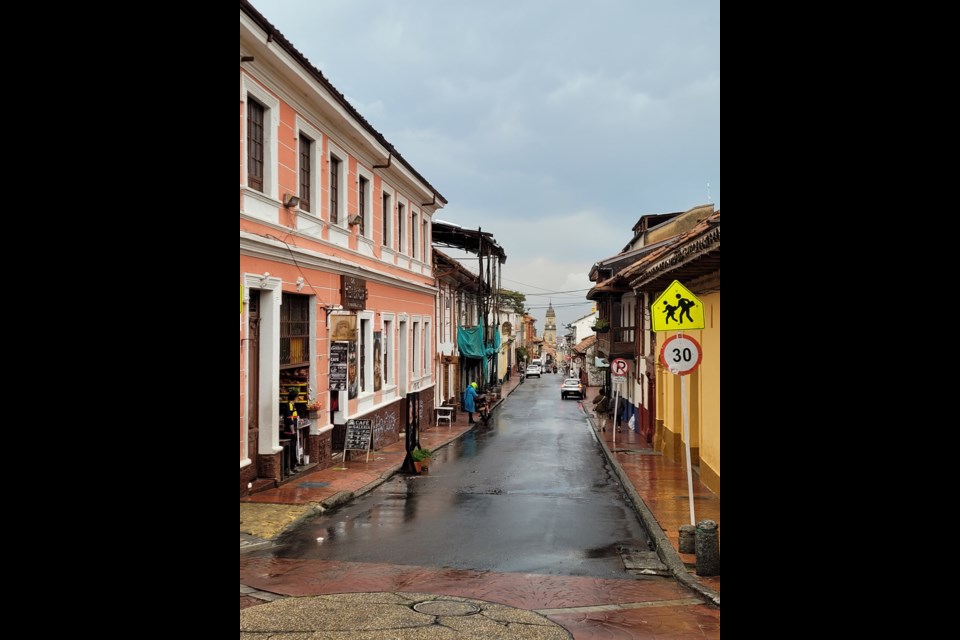“It’s controlled chaos,” my partner remarks as we watch drivers weave in and out of rush-hour traffic in Bogotá, Colombia.
“But I trust them. They know what they’re doing.”
It’s a fitting introduction to Colombia’s teeming capital of roughly 9 million. For those, like us, accustomed to the comparatively placid experience of the modern Canadian city, Bogotá can at first feel like sensory overload. Fruit vendors beckon with low, melodic calls of aguacate, vibrant murals adorn nearly every available inch of wall space, and scores of restaurants and storefronts only add to the cacophony by blasting competing cumbia songs from prodigious speaker set-ups.
The urban symphony has the not-unpleasant effect of constantly ushering you back to the present, a sort of involuntary mindfulness we’ll notice throughout our time here.
It’s hard not to be present in one of Bogotá’s largest markets, the Paloquomao. Featuring a mind-boggling and mouth-watering array of fruit, vegetables, flowers, meat and fish, the Paloquomao dates back to 1946 and serves as a showcase of the country’s rich biodiversity. Because Colombia is marked by three large mountain ranges, you can travel a handful of hours in pretty much any direction and find yourself in a totally different ecosystem. That diversity also means the country is home to some of the tastiest and most unusual fruit in the world, much of which will be completely unfamiliar to the average Canadian (along with inarguably better versions of more common fruit, like passionfruit, guava, mango, and the biggest avocadoes you’ve ever seen.) There’s an abundance of delicious fruits to sample at the market, but my personal favourites are guama, also known as “monkey fruit” and “ice-cream bean” for the sweet flavour and smooth texture of its pulp; lulo, a tart, citrus-like fruit favoured in drinks and desserts that looks like a tomato from the outside but tastes like anything but; and guanábana, known in English as soursop, a large, spiky marvel of a fruit that tastes like a mix of strawberry, apple and citrus, with a white, creamy pulp inside that has a similar texture to banana.
The market also features plenty of no-fuss food stalls, where you can whet your appetite with some of Colombia’s comida típica, a hearty cuisine that leans towards fresh ingredients and insanely massive portions. You can’t go wrong with Bogotános’ favourite soup, ajiaco santafereño, typically made with chicken, three kinds of potatoes, and a local green herb known as guasco. For the truly famished, order a bandeja paisa, a gargantuan farmer’s platter that typically includes (although there are many regional variations) rice, red beans, ground beef or pork, chorizo, black pudding, crunchy chicharrón, fried egg, plantain and avocado.
On our second day, still catching up on sleep, we head to Divino Café Especial in the heart of Bogotá’s romantic, cobblestone-lined colonial district, La Candelaria, where we meet Leandro Galindo, a third-generation coffee farmer whose knowledge of coffee is only rivalled by his easygoing charm. Looking like something out of a science lab, Leandro has set up an extensive coffee-tasting experience for us, crystal beakers, Chemex coffeemakers, and wine glasses lining the table, as the faint aromas of freshly ground beans permeate the room. (To arrange a tasting, email Leandro at [email protected].)
Even for caffeine junkies such as ourselves, the experience is incredibly informative, as Leandro walks us through his family’s growing techniques, flavour notes, and the different methods for brewing the perfect cup, tailored to our particular taste. It’s clear Leandro and his family are at the vanguard of Colombia’s artisanal coffee movement, a country that, sadly, has only in recent years begun to appreciate the high-quality coffee available in its own backyard, due to it being out of the price range of the average citizen, with the majority of single-origin beans exported to North America and Europe.
A welcome change of pace from the frenetic energy of El Centro, we ride a gondola up to one of Bogotá’s most recognizable landmarks, Monserrate, visible from nearly every part of the city. An imposing mountain considered sacred by the Indigenous Muisca who inhabited the area in pre-Columbian times, it became a popular pilgrimage site for colonial-era settlers. Whether for fitness or religious reasons, Colombians today continue to make the thigh-burning trek—although you can also take a scenic ride on a gondola or funicular railway—to a monastery built in the 1600s at the mountain’s peak. On the day we visit, we watch as one of the faithful crawls, barefoot, on hands and knees up the church’s central nave. Outside the monastery you’ll find cafés, restaurants and vendors selling all kinds of touristy kitsch, both religious and not, but Monserrate’s real draw is its breathtaking views. Perched 3,000 metres high, it’s the perfect spot to take in the Bogota skyline, as well as bear witness to the city’s notoriously moody weather; in the hour or so we were there, the skies turned from sunny to overcast to full-on hail storm, proving that old Mark Twain adage that if you don’t like the weather, just wait 10 minutes.
This is Part 1 of 3 of Brandon Barrett’s travel series on Colombia. Pick up the Nov. 25 edition of Pique for the next instalment on the Colombian Amazon.





